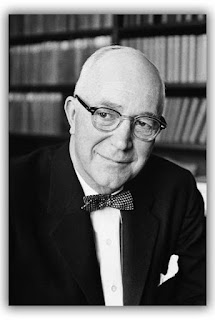 |
| Gordon Allport |
While all varieties of religious belief share the flaws of irrationality and falsehood, there is evidence that some forms of religious belief are less damaging than others. In fact, the intrinsic-extrinsic dimension has been one of the most central constructs in the modern psychology of religion and remains popular in psychological research today.
It is difficult to read much on the psychology of religion without encountering Gordon Allport's work on intrinsic-extrinsic religion. Essentially, this dimension deals with maturity and is based on the assumption that some people hold more mature religious belief than others. It may be tempting for nonbelievers to dismiss this notion, especially when one learns that Allport developed it at least in part because he was troubled by the positive relationship between measures of religiosity and measures of prejudice.
Interesting how this works, isn't it? A researcher finds that religiosity is positively correlated with prejudice (i.e., people with higher reported religiosity report greater levels of prejudice), is puzzled by this finding, and decides that there must be something else going on besides the obvious explanation. Still, I think we can rest assured that there is a considerable body of scientific research supporting the utility of the I-E construct.
Simply put, an intrinsic (I) religious orientation is described as being more mature in that the believer views religion as an end unto itself. That is, the believer believes without clearly identifiable external motives for doing so. In contrast, an extrinsic (E) religious orientation is immature and is more of a means to some other end. That is, belief motivated by external factors (e.g., social acceptance, advancement, etc.). E (but not I) is correlated with prejudice.
Modern I-E scales are set up so that I and E are thought of as separate constructs where individuals score along two separate dimensions (i.e., low E to high E and low I to high I). Research has identified many negative correlates of high E (e.g., narcissism, guilt, fear of death, aggression, etc.).
Current work in the psychology of religion is characterized by the assumption that measuring religiosity as a unitary construct produces misleading results. Instead, the field has been influenced by the separation of religiosity into E and I orientations. The practical implication is that most of what we think of as the negative correlates of religious belief have been supported for extrinsic religiosity but not intrinsic religiosity. It is also noteworthy that extrinsic religiosity is much more highly correlated with measures of religious fundamentalism than is intrinsic religiosity.